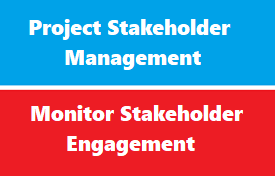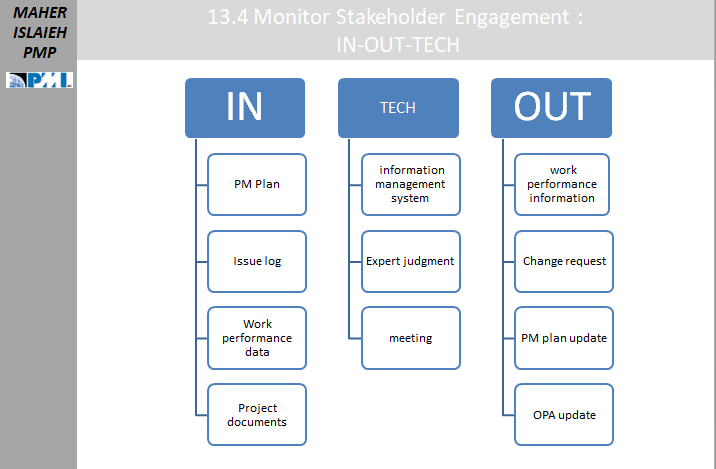introduction
Control Stakeholder Engagement is the process of monitoring overall project stakeholder relationships and adjusting strategies and plans for engaging stakeholders.
The key benefit of this process is that it will maintain or increase the efficiency and effectiveness of stakeholder engagement activities as the project evolves and its environment changes
title
Text
title
Text
title
Text
title
Text
process inputs
Monitor Stakeholder Engagement: Inputs
Project Management Plan
PM Plan include :
- Stakeholder management plan–this gives guidelines and information on how to do all of the other processes in the stakeholder management knowledge area, including this managing and monitoring stakeholder needs and expectations.
- Resource management plan–for methods for management of team members
- Communications engagement plan–defines the plans and strategies for communication to the project’s stakeholders.
Project Documents
- Issue log–stakeholder concerns are documented in the issue log, as well as any assigned action items associated with managing the issue.
- Lessons learned register–as lessons are learned in the course of managing stakeholder engagement, they can be be applied to later phases in the project to improve the efficiency and effectiveness of this process.
- Project communications–communications that have been previous distributed to stakeholders as defined in both the communications and stakeholder management plans.
- Risk register–identifies risks for the project, including those related to stakeholder engagement.
- Stakeholder register–provides the list of project stakeholders and any information needed to execute the stakeholder engagement plan.
Work Performance Data
- In particular, which stakeholders are currently supportive of the project, vs. neutral or resistant.
Enterprise Environmental Factors
EEF Like :
- Organizational culture, political climate, and governance structure of the organization
- Personnel administration policies
- Stakeholder risk thresholds
- Established communication channels
Organizational Process Assets
OPA Like :
- Corporate policies and procedures for social media
- Corporate policies and procedures for issue, risk, change and data management
- Organizational communications requirements
process - techniques
Monitor Stakeholder Engagement: Tools and Techniques
Data Analysis
- Stakeholder analysis–helps determine the current position of stakeholders with regards to their engagement
- Root cause analysis–used to determine the basic underlying reason that stakeholder engagement is not yet having the planned effect.
- Alternatives analysis–used to evaluate options to respond to variances in the desired results of stakeholder engagement.
Decision Making
- Multicriteria decision analysis–several factors for successful stakeholder engagement are prioritized and weighted in order to help identify the most appropriate choice.
- Voting–used to select the best response for a variance in stakeholder engagement.
Data Representation
- The stakeholder engagement assessment matrix, introduced as an output of Plan Stakeholder Engagement,
- is used to chart the progress in bringing the current level of stakeholder engagement
Communication Skills
- Feedback–ensuring that information given to stakeholders is received and understood
- Presentation–presentations provide clear information to stakeholders, and more effective than e-mails, newsletters,
Interpersonal and Team Skills
- Active listening–used to reduce misunderstandings and other miscommunication
- Cultural awareness–cultural awareness and cultural sensitivity help the project manager to plan communications based on the cultural differences and requirements of stakeholders and team members. For more information on cultural awareness, read The Culture Map by Erin Meyer.
- Leadership–strong leadership skills will help communicate the vision of your project to stakeholders and inspire them to support the work and outcomes of the project.
- Networking–ensures access to information about levels of engagement of stakeholders.
- Political awareness–used to understand the strategies of the organization, understand who wields power and influence, and to develop an ability to communicate with these stakeholders.
process - outputs
Monitor Stakeholder Engagement: Outputs
Work Performance Information
- WPI represents the current status of stakeholder engagement
- to what degree does the stakeholder support the current project, as compared to the desired levels of stakeholder engagement.
Change Requests
- if any change requests are made as a result, then these change requests are processed in process Perform Integrated Change Control ICC
Project Management Plan Updates
update will be:
- Stakeholder engagement plan–any updates regarding information about stakeholders are added to this component
- Resource management plan–the project team’s responsibilities for stakeholder engagement activities may need to be updated.
- Communications management plan—the communication strategies for engaging with stakeholders may need to be updated.
Project Document Updates
The document that needs to be updated,:
- Stakeholder register–new information about stakeholders is updated as a result of this process of monitoring stakeholder engagement.
- Issue log–if any stakeholders attitudes have changed towards any of the existing issues in the issue log, then the log may need to be updated.
- Lessons learned register–if as a result of engaging stakeholders, any lessons are learned about challenges and how they could have been avoided, then these are added to the register. Of course, if approaches turn out well, then these positive lessons should also be added to the register.
- Risk register–if any risk are related specifically to stakeholders, then these may need to be updated as a result of interaction with the stakeholders as a result of this process.


